Improving Support: Domestic Violence in Indigenous Australia
VerifiedAdded on 2022/10/16
|8
|1769
|21
Report
AI Summary
This social work report addresses the critical issue of domestic violence within Indigenous communities in Australia. It begins by defining domestic violence according to the Family Law Act 1975 and highlights its prevalence across various demographics, with a specific focus on the intensified impact on Indigenous Australians. The report provides an overview of the current scenario, citing data from the Australian Institute of Health and Welfare and other sources, emphasizing the disproportionately high rates of domestic violence experienced by Indigenous women. It then examines existing policies, including the Family and Domestic Violence Strategy 2016-19, and identifies shortcomings in the current approach, particularly concerning the implementation of national action plans and their responsiveness to specific regional contexts. The Bacchi Model is applied to critically analyze the policies. The report proposes policy changes, evaluates their feasibility considering socio-political factors, and discusses the role of advocacy in promoting these changes. The conclusion summarizes the key findings and emphasizes the need for targeted interventions to address domestic violence within Indigenous communities. The report references various sources like the Australian Law Reform Commission and the Better Health Channel.
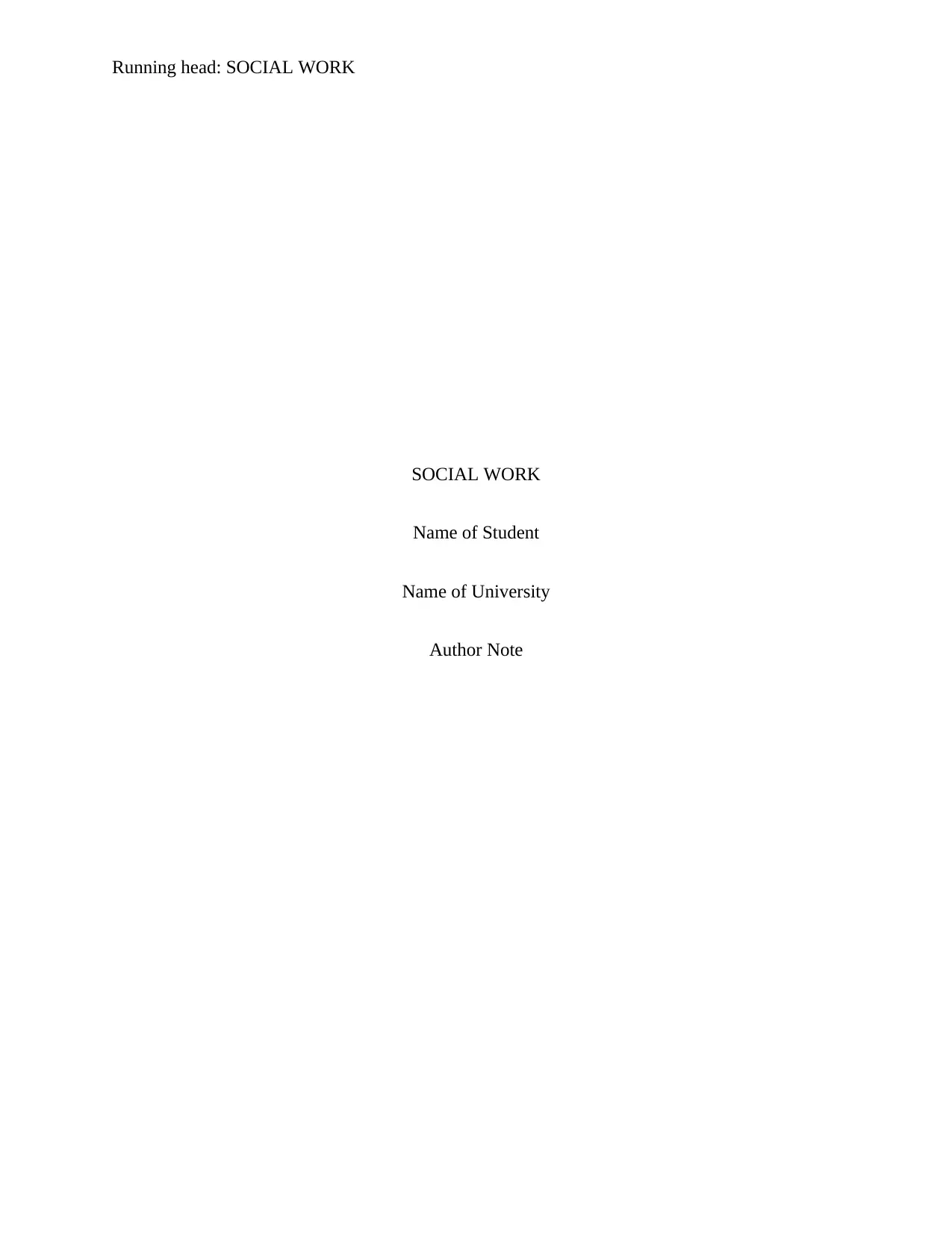
Running head: SOCIAL WORK
SOCIAL WORK
Name of Student
Name of University
Author Note
SOCIAL WORK
Name of Student
Name of University
Author Note
Paraphrase This Document
Need a fresh take? Get an instant paraphrase of this document with our AI Paraphraser
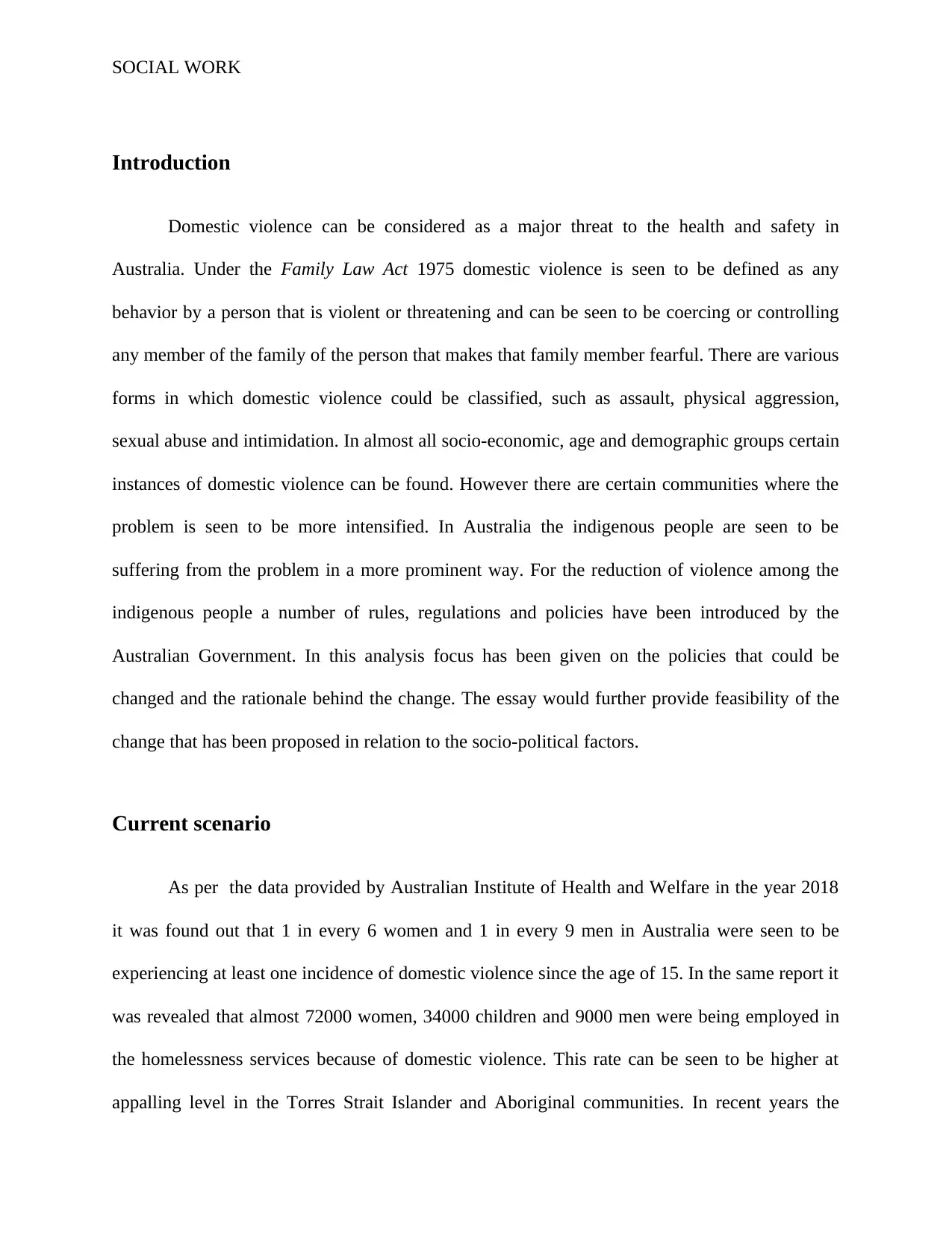
SOCIAL WORK
Introduction
Domestic violence can be considered as a major threat to the health and safety in
Australia. Under the Family Law Act 1975 domestic violence is seen to be defined as any
behavior by a person that is violent or threatening and can be seen to be coercing or controlling
any member of the family of the person that makes that family member fearful. There are various
forms in which domestic violence could be classified, such as assault, physical aggression,
sexual abuse and intimidation. In almost all socio-economic, age and demographic groups certain
instances of domestic violence can be found. However there are certain communities where the
problem is seen to be more intensified. In Australia the indigenous people are seen to be
suffering from the problem in a more prominent way. For the reduction of violence among the
indigenous people a number of rules, regulations and policies have been introduced by the
Australian Government. In this analysis focus has been given on the policies that could be
changed and the rationale behind the change. The essay would further provide feasibility of the
change that has been proposed in relation to the socio-political factors.
Current scenario
As per the data provided by Australian Institute of Health and Welfare in the year 2018
it was found out that 1 in every 6 women and 1 in every 9 men in Australia were seen to be
experiencing at least one incidence of domestic violence since the age of 15. In the same report it
was revealed that almost 72000 women, 34000 children and 9000 men were being employed in
the homelessness services because of domestic violence. This rate can be seen to be higher at
appalling level in the Torres Strait Islander and Aboriginal communities. In recent years the
Introduction
Domestic violence can be considered as a major threat to the health and safety in
Australia. Under the Family Law Act 1975 domestic violence is seen to be defined as any
behavior by a person that is violent or threatening and can be seen to be coercing or controlling
any member of the family of the person that makes that family member fearful. There are various
forms in which domestic violence could be classified, such as assault, physical aggression,
sexual abuse and intimidation. In almost all socio-economic, age and demographic groups certain
instances of domestic violence can be found. However there are certain communities where the
problem is seen to be more intensified. In Australia the indigenous people are seen to be
suffering from the problem in a more prominent way. For the reduction of violence among the
indigenous people a number of rules, regulations and policies have been introduced by the
Australian Government. In this analysis focus has been given on the policies that could be
changed and the rationale behind the change. The essay would further provide feasibility of the
change that has been proposed in relation to the socio-political factors.
Current scenario
As per the data provided by Australian Institute of Health and Welfare in the year 2018
it was found out that 1 in every 6 women and 1 in every 9 men in Australia were seen to be
experiencing at least one incidence of domestic violence since the age of 15. In the same report it
was revealed that almost 72000 women, 34000 children and 9000 men were being employed in
the homelessness services because of domestic violence. This rate can be seen to be higher at
appalling level in the Torres Strait Islander and Aboriginal communities. In recent years the
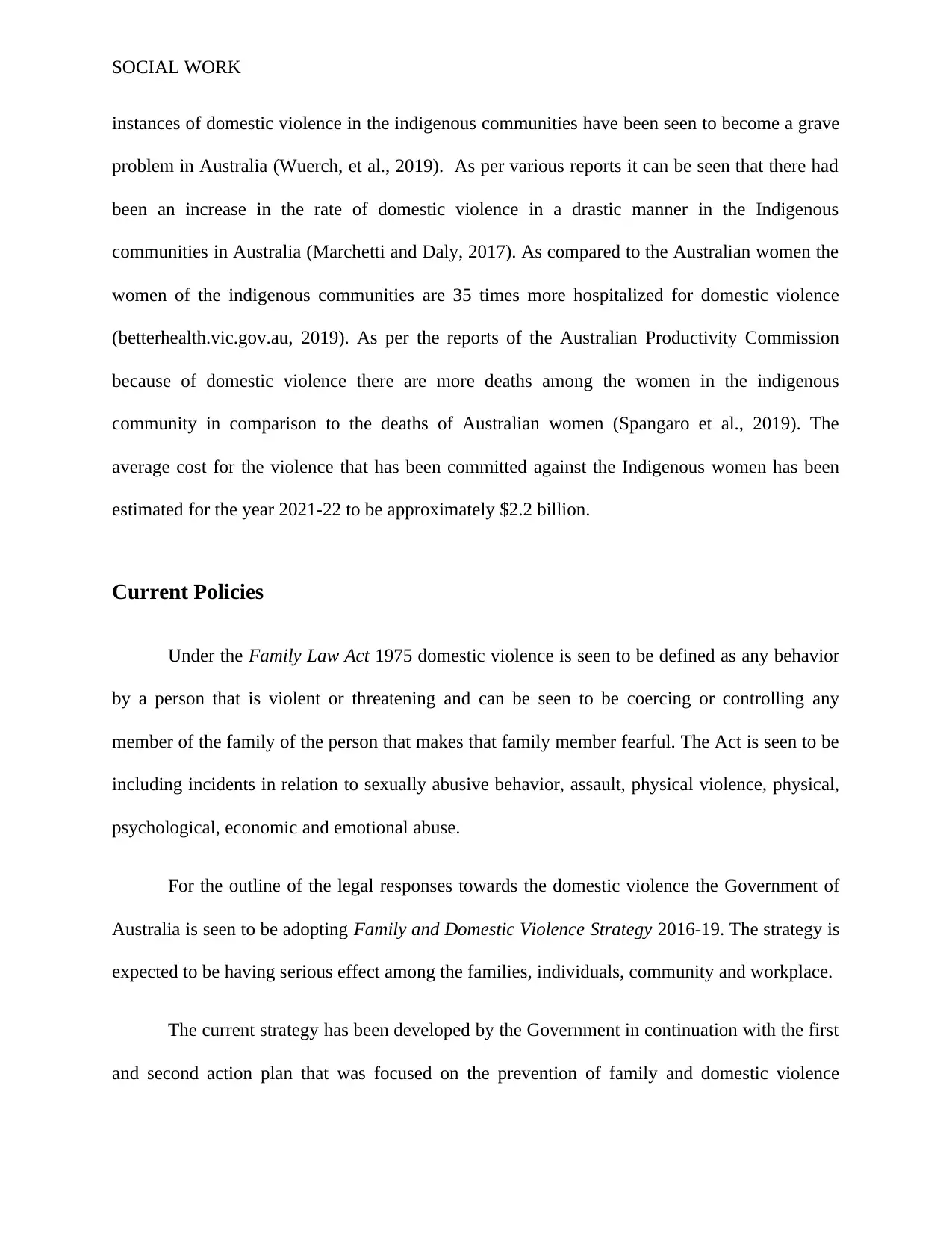
SOCIAL WORK
instances of domestic violence in the indigenous communities have been seen to become a grave
problem in Australia (Wuerch, et al., 2019). As per various reports it can be seen that there had
been an increase in the rate of domestic violence in a drastic manner in the Indigenous
communities in Australia (Marchetti and Daly, 2017). As compared to the Australian women the
women of the indigenous communities are 35 times more hospitalized for domestic violence
(betterhealth.vic.gov.au, 2019). As per the reports of the Australian Productivity Commission
because of domestic violence there are more deaths among the women in the indigenous
community in comparison to the deaths of Australian women (Spangaro et al., 2019). The
average cost for the violence that has been committed against the Indigenous women has been
estimated for the year 2021-22 to be approximately $2.2 billion.
Current Policies
Under the Family Law Act 1975 domestic violence is seen to be defined as any behavior
by a person that is violent or threatening and can be seen to be coercing or controlling any
member of the family of the person that makes that family member fearful. The Act is seen to be
including incidents in relation to sexually abusive behavior, assault, physical violence, physical,
psychological, economic and emotional abuse.
For the outline of the legal responses towards the domestic violence the Government of
Australia is seen to be adopting Family and Domestic Violence Strategy 2016-19. The strategy is
expected to be having serious effect among the families, individuals, community and workplace.
The current strategy has been developed by the Government in continuation with the first
and second action plan that was focused on the prevention of family and domestic violence
instances of domestic violence in the indigenous communities have been seen to become a grave
problem in Australia (Wuerch, et al., 2019). As per various reports it can be seen that there had
been an increase in the rate of domestic violence in a drastic manner in the Indigenous
communities in Australia (Marchetti and Daly, 2017). As compared to the Australian women the
women of the indigenous communities are 35 times more hospitalized for domestic violence
(betterhealth.vic.gov.au, 2019). As per the reports of the Australian Productivity Commission
because of domestic violence there are more deaths among the women in the indigenous
community in comparison to the deaths of Australian women (Spangaro et al., 2019). The
average cost for the violence that has been committed against the Indigenous women has been
estimated for the year 2021-22 to be approximately $2.2 billion.
Current Policies
Under the Family Law Act 1975 domestic violence is seen to be defined as any behavior
by a person that is violent or threatening and can be seen to be coercing or controlling any
member of the family of the person that makes that family member fearful. The Act is seen to be
including incidents in relation to sexually abusive behavior, assault, physical violence, physical,
psychological, economic and emotional abuse.
For the outline of the legal responses towards the domestic violence the Government of
Australia is seen to be adopting Family and Domestic Violence Strategy 2016-19. The strategy is
expected to be having serious effect among the families, individuals, community and workplace.
The current strategy has been developed by the Government in continuation with the first
and second action plan that was focused on the prevention of family and domestic violence
⊘ This is a preview!⊘
Do you want full access?
Subscribe today to unlock all pages.

Trusted by 1+ million students worldwide
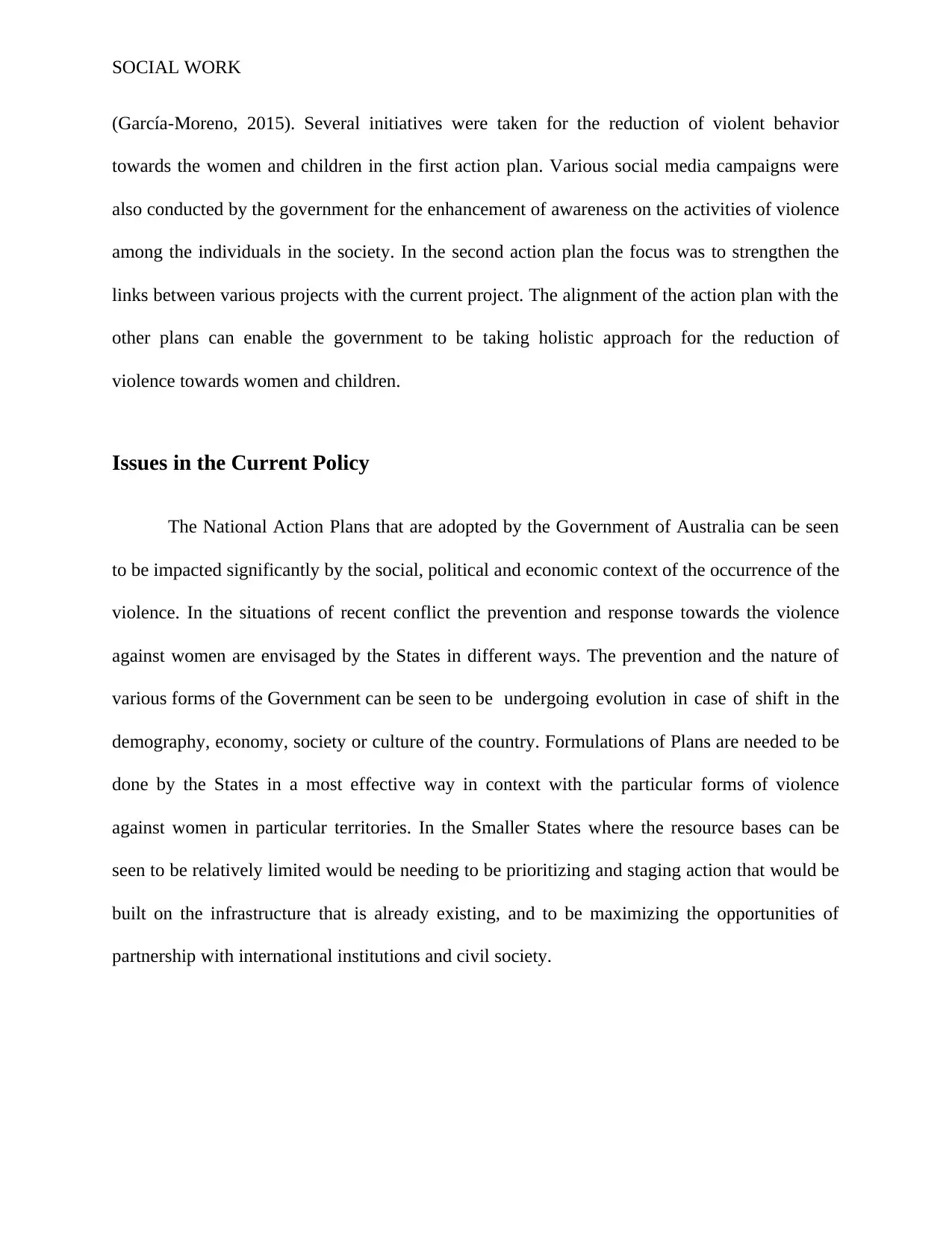
SOCIAL WORK
(García-Moreno, 2015). Several initiatives were taken for the reduction of violent behavior
towards the women and children in the first action plan. Various social media campaigns were
also conducted by the government for the enhancement of awareness on the activities of violence
among the individuals in the society. In the second action plan the focus was to strengthen the
links between various projects with the current project. The alignment of the action plan with the
other plans can enable the government to be taking holistic approach for the reduction of
violence towards women and children.
Issues in the Current Policy
The National Action Plans that are adopted by the Government of Australia can be seen
to be impacted significantly by the social, political and economic context of the occurrence of the
violence. In the situations of recent conflict the prevention and response towards the violence
against women are envisaged by the States in different ways. The prevention and the nature of
various forms of the Government can be seen to be undergoing evolution in case of shift in the
demography, economy, society or culture of the country. Formulations of Plans are needed to be
done by the States in a most effective way in context with the particular forms of violence
against women in particular territories. In the Smaller States where the resource bases can be
seen to be relatively limited would be needing to be prioritizing and staging action that would be
built on the infrastructure that is already existing, and to be maximizing the opportunities of
partnership with international institutions and civil society.
(García-Moreno, 2015). Several initiatives were taken for the reduction of violent behavior
towards the women and children in the first action plan. Various social media campaigns were
also conducted by the government for the enhancement of awareness on the activities of violence
among the individuals in the society. In the second action plan the focus was to strengthen the
links between various projects with the current project. The alignment of the action plan with the
other plans can enable the government to be taking holistic approach for the reduction of
violence towards women and children.
Issues in the Current Policy
The National Action Plans that are adopted by the Government of Australia can be seen
to be impacted significantly by the social, political and economic context of the occurrence of the
violence. In the situations of recent conflict the prevention and response towards the violence
against women are envisaged by the States in different ways. The prevention and the nature of
various forms of the Government can be seen to be undergoing evolution in case of shift in the
demography, economy, society or culture of the country. Formulations of Plans are needed to be
done by the States in a most effective way in context with the particular forms of violence
against women in particular territories. In the Smaller States where the resource bases can be
seen to be relatively limited would be needing to be prioritizing and staging action that would be
built on the infrastructure that is already existing, and to be maximizing the opportunities of
partnership with international institutions and civil society.
Paraphrase This Document
Need a fresh take? Get an instant paraphrase of this document with our AI Paraphraser
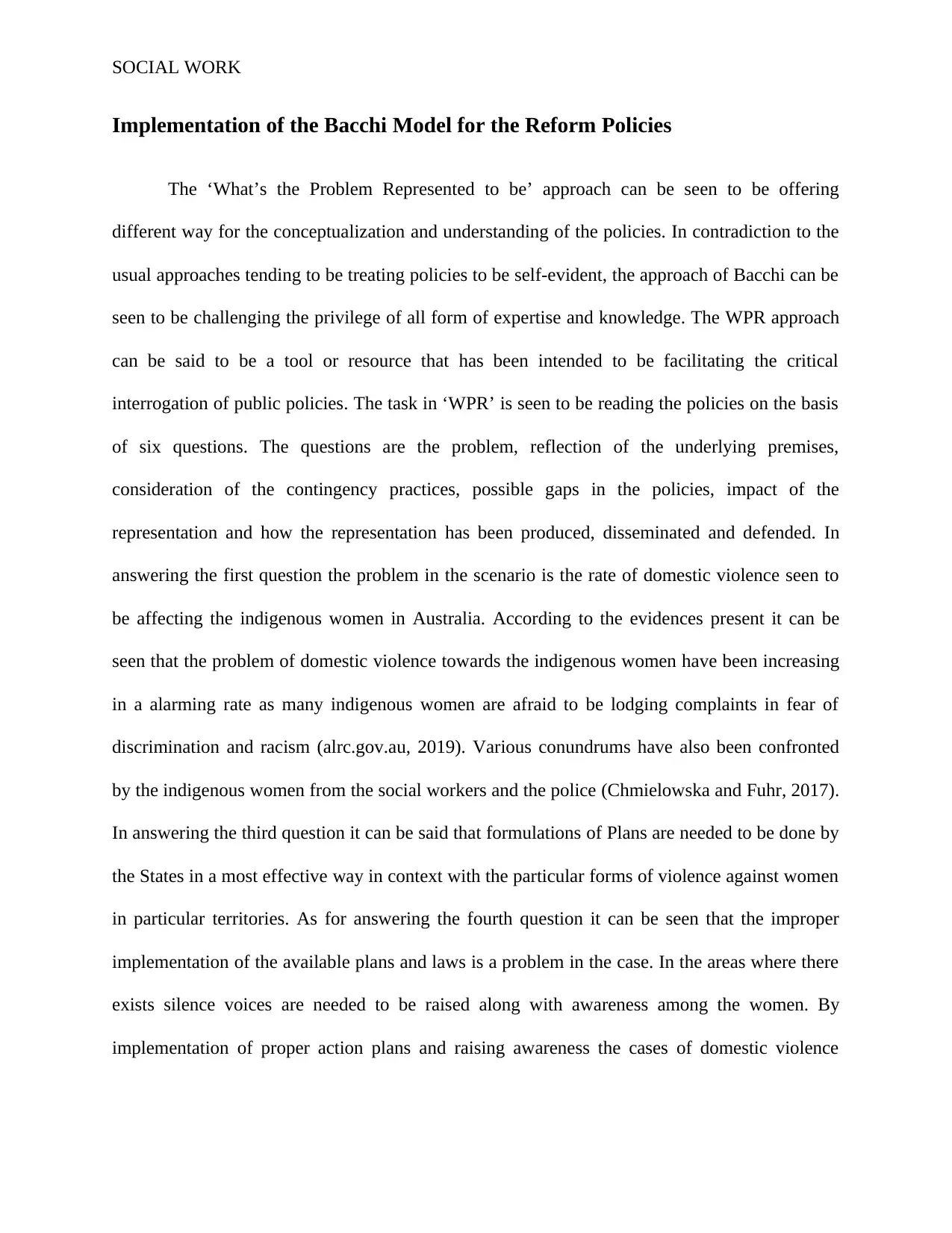
SOCIAL WORK
Implementation of the Bacchi Model for the Reform Policies
The ‘What’s the Problem Represented to be’ approach can be seen to be offering
different way for the conceptualization and understanding of the policies. In contradiction to the
usual approaches tending to be treating policies to be self-evident, the approach of Bacchi can be
seen to be challenging the privilege of all form of expertise and knowledge. The WPR approach
can be said to be a tool or resource that has been intended to be facilitating the critical
interrogation of public policies. The task in ‘WPR’ is seen to be reading the policies on the basis
of six questions. The questions are the problem, reflection of the underlying premises,
consideration of the contingency practices, possible gaps in the policies, impact of the
representation and how the representation has been produced, disseminated and defended. In
answering the first question the problem in the scenario is the rate of domestic violence seen to
be affecting the indigenous women in Australia. According to the evidences present it can be
seen that the problem of domestic violence towards the indigenous women have been increasing
in a alarming rate as many indigenous women are afraid to be lodging complaints in fear of
discrimination and racism (alrc.gov.au, 2019). Various conundrums have also been confronted
by the indigenous women from the social workers and the police (Chmielowska and Fuhr, 2017).
In answering the third question it can be said that formulations of Plans are needed to be done by
the States in a most effective way in context with the particular forms of violence against women
in particular territories. As for answering the fourth question it can be seen that the improper
implementation of the available plans and laws is a problem in the case. In the areas where there
exists silence voices are needed to be raised along with awareness among the women. By
implementation of proper action plans and raising awareness the cases of domestic violence
Implementation of the Bacchi Model for the Reform Policies
The ‘What’s the Problem Represented to be’ approach can be seen to be offering
different way for the conceptualization and understanding of the policies. In contradiction to the
usual approaches tending to be treating policies to be self-evident, the approach of Bacchi can be
seen to be challenging the privilege of all form of expertise and knowledge. The WPR approach
can be said to be a tool or resource that has been intended to be facilitating the critical
interrogation of public policies. The task in ‘WPR’ is seen to be reading the policies on the basis
of six questions. The questions are the problem, reflection of the underlying premises,
consideration of the contingency practices, possible gaps in the policies, impact of the
representation and how the representation has been produced, disseminated and defended. In
answering the first question the problem in the scenario is the rate of domestic violence seen to
be affecting the indigenous women in Australia. According to the evidences present it can be
seen that the problem of domestic violence towards the indigenous women have been increasing
in a alarming rate as many indigenous women are afraid to be lodging complaints in fear of
discrimination and racism (alrc.gov.au, 2019). Various conundrums have also been confronted
by the indigenous women from the social workers and the police (Chmielowska and Fuhr, 2017).
In answering the third question it can be said that formulations of Plans are needed to be done by
the States in a most effective way in context with the particular forms of violence against women
in particular territories. As for answering the fourth question it can be seen that the improper
implementation of the available plans and laws is a problem in the case. In the areas where there
exists silence voices are needed to be raised along with awareness among the women. By
implementation of proper action plans and raising awareness the cases of domestic violence
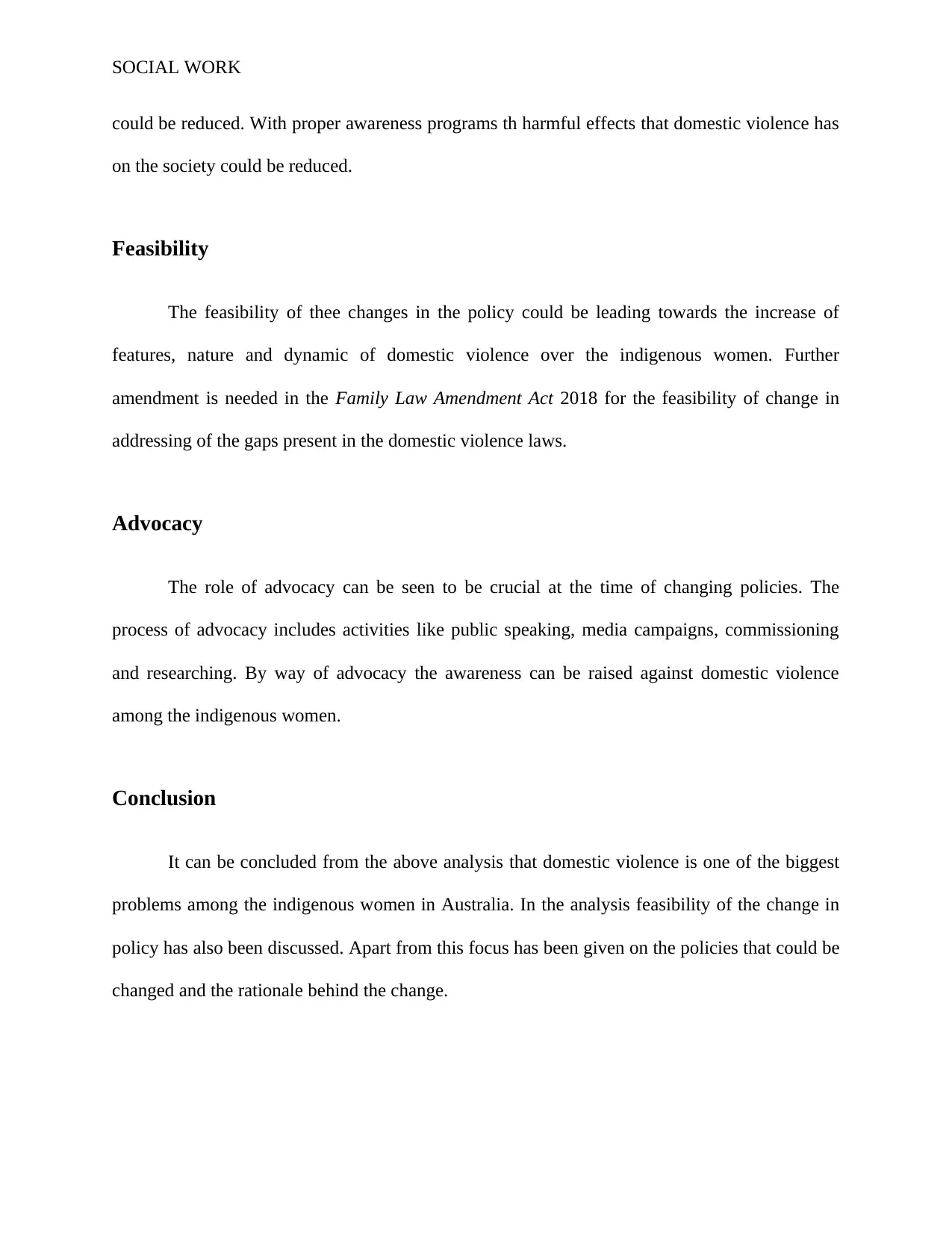
SOCIAL WORK
could be reduced. With proper awareness programs th harmful effects that domestic violence has
on the society could be reduced.
Feasibility
The feasibility of thee changes in the policy could be leading towards the increase of
features, nature and dynamic of domestic violence over the indigenous women. Further
amendment is needed in the Family Law Amendment Act 2018 for the feasibility of change in
addressing of the gaps present in the domestic violence laws.
Advocacy
The role of advocacy can be seen to be crucial at the time of changing policies. The
process of advocacy includes activities like public speaking, media campaigns, commissioning
and researching. By way of advocacy the awareness can be raised against domestic violence
among the indigenous women.
Conclusion
It can be concluded from the above analysis that domestic violence is one of the biggest
problems among the indigenous women in Australia. In the analysis feasibility of the change in
policy has also been discussed. Apart from this focus has been given on the policies that could be
changed and the rationale behind the change.
could be reduced. With proper awareness programs th harmful effects that domestic violence has
on the society could be reduced.
Feasibility
The feasibility of thee changes in the policy could be leading towards the increase of
features, nature and dynamic of domestic violence over the indigenous women. Further
amendment is needed in the Family Law Amendment Act 2018 for the feasibility of change in
addressing of the gaps present in the domestic violence laws.
Advocacy
The role of advocacy can be seen to be crucial at the time of changing policies. The
process of advocacy includes activities like public speaking, media campaigns, commissioning
and researching. By way of advocacy the awareness can be raised against domestic violence
among the indigenous women.
Conclusion
It can be concluded from the above analysis that domestic violence is one of the biggest
problems among the indigenous women in Australia. In the analysis feasibility of the change in
policy has also been discussed. Apart from this focus has been given on the policies that could be
changed and the rationale behind the change.
⊘ This is a preview!⊘
Do you want full access?
Subscribe today to unlock all pages.

Trusted by 1+ million students worldwide
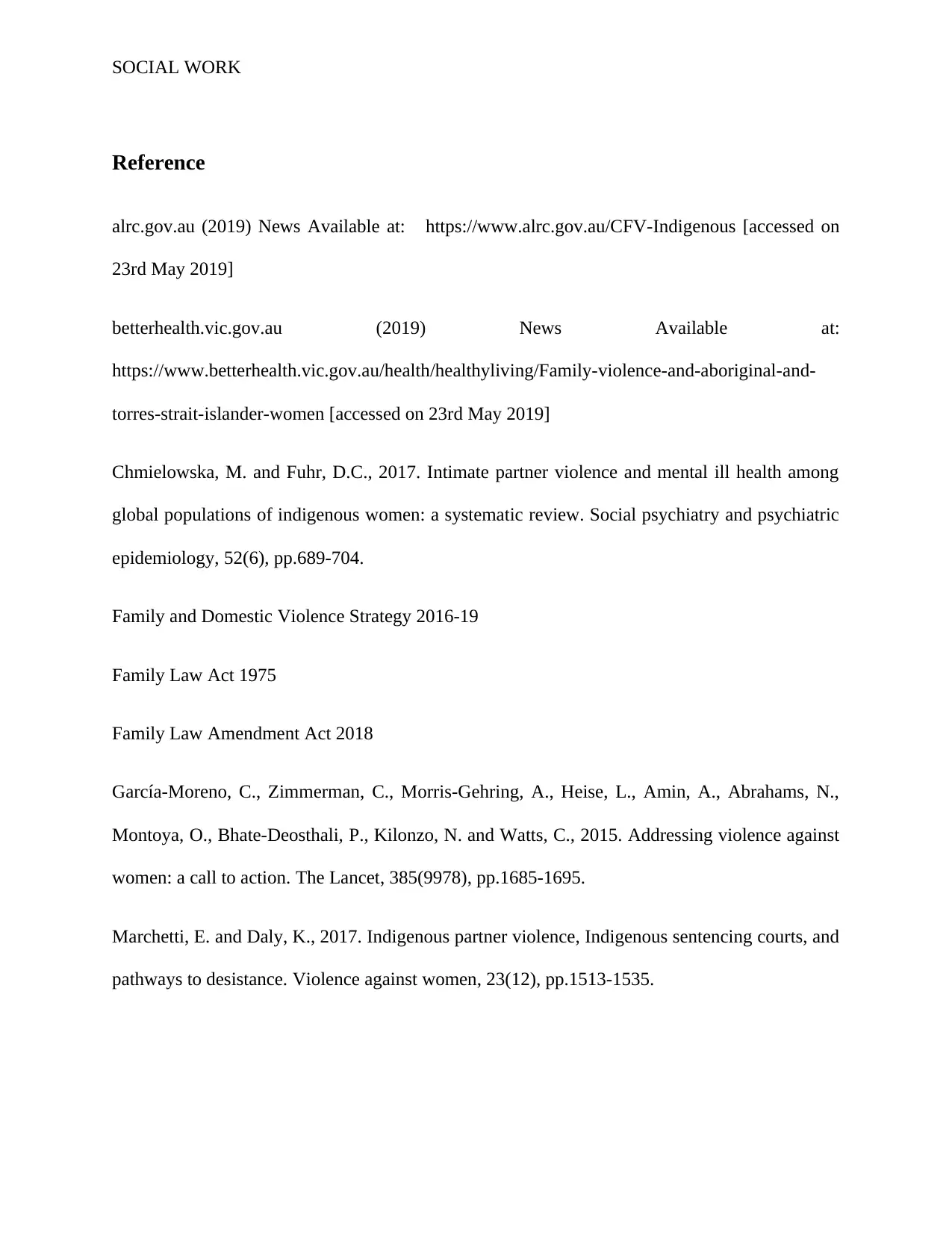
SOCIAL WORK
Reference
alrc.gov.au (2019) News Available at: https://www.alrc.gov.au/CFV-Indigenous [accessed on
23rd May 2019]
betterhealth.vic.gov.au (2019) News Available at:
https://www.betterhealth.vic.gov.au/health/healthyliving/Family-violence-and-aboriginal-and-
torres-strait-islander-women [accessed on 23rd May 2019]
Chmielowska, M. and Fuhr, D.C., 2017. Intimate partner violence and mental ill health among
global populations of indigenous women: a systematic review. Social psychiatry and psychiatric
epidemiology, 52(6), pp.689-704.
Family and Domestic Violence Strategy 2016-19
Family Law Act 1975
Family Law Amendment Act 2018
García-Moreno, C., Zimmerman, C., Morris-Gehring, A., Heise, L., Amin, A., Abrahams, N.,
Montoya, O., Bhate-Deosthali, P., Kilonzo, N. and Watts, C., 2015. Addressing violence against
women: a call to action. The Lancet, 385(9978), pp.1685-1695.
Marchetti, E. and Daly, K., 2017. Indigenous partner violence, Indigenous sentencing courts, and
pathways to desistance. Violence against women, 23(12), pp.1513-1535.
Reference
alrc.gov.au (2019) News Available at: https://www.alrc.gov.au/CFV-Indigenous [accessed on
23rd May 2019]
betterhealth.vic.gov.au (2019) News Available at:
https://www.betterhealth.vic.gov.au/health/healthyliving/Family-violence-and-aboriginal-and-
torres-strait-islander-women [accessed on 23rd May 2019]
Chmielowska, M. and Fuhr, D.C., 2017. Intimate partner violence and mental ill health among
global populations of indigenous women: a systematic review. Social psychiatry and psychiatric
epidemiology, 52(6), pp.689-704.
Family and Domestic Violence Strategy 2016-19
Family Law Act 1975
Family Law Amendment Act 2018
García-Moreno, C., Zimmerman, C., Morris-Gehring, A., Heise, L., Amin, A., Abrahams, N.,
Montoya, O., Bhate-Deosthali, P., Kilonzo, N. and Watts, C., 2015. Addressing violence against
women: a call to action. The Lancet, 385(9978), pp.1685-1695.
Marchetti, E. and Daly, K., 2017. Indigenous partner violence, Indigenous sentencing courts, and
pathways to desistance. Violence against women, 23(12), pp.1513-1535.
Paraphrase This Document
Need a fresh take? Get an instant paraphrase of this document with our AI Paraphraser
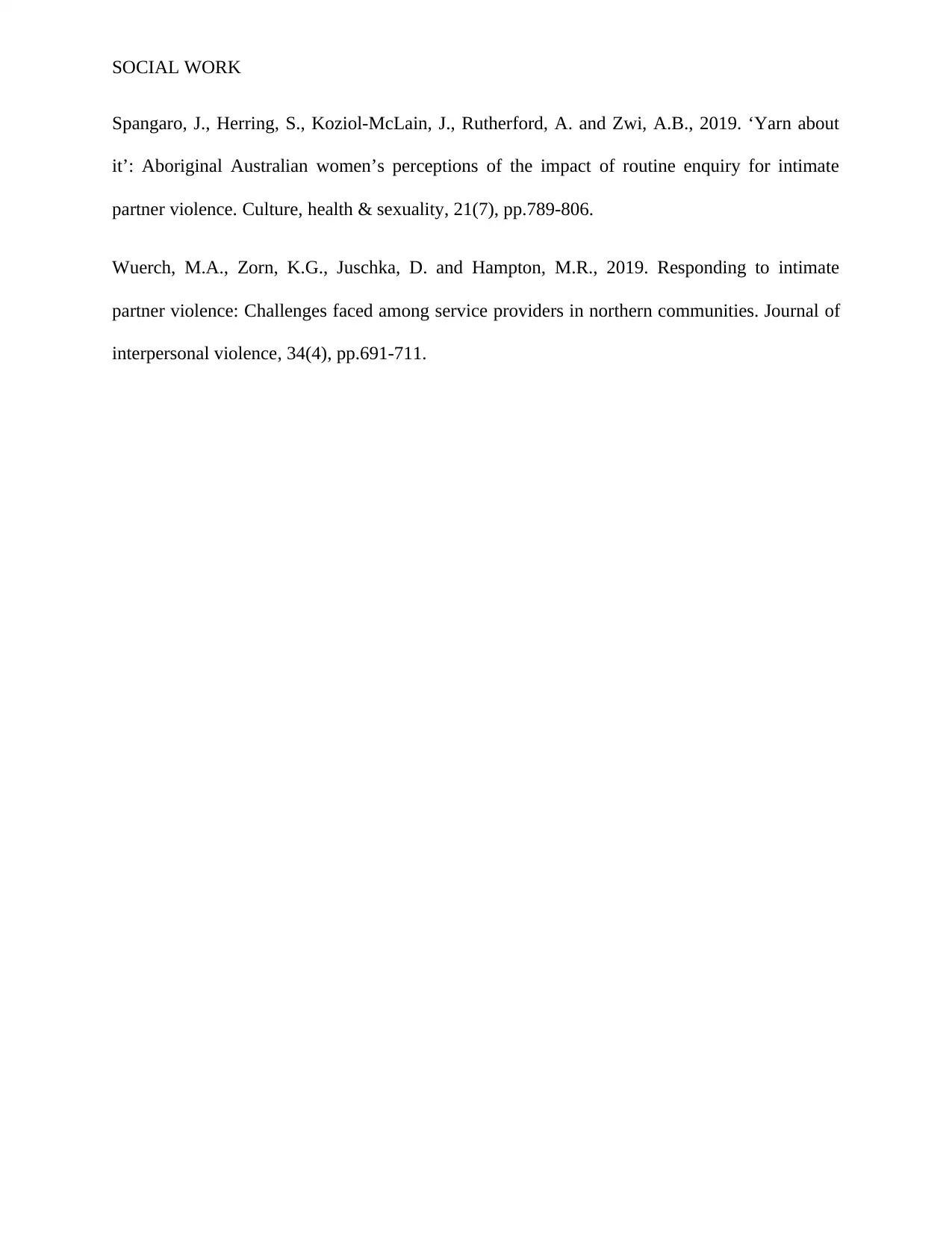
SOCIAL WORK
Spangaro, J., Herring, S., Koziol-McLain, J., Rutherford, A. and Zwi, A.B., 2019. ‘Yarn about
it’: Aboriginal Australian women’s perceptions of the impact of routine enquiry for intimate
partner violence. Culture, health & sexuality, 21(7), pp.789-806.
Wuerch, M.A., Zorn, K.G., Juschka, D. and Hampton, M.R., 2019. Responding to intimate
partner violence: Challenges faced among service providers in northern communities. Journal of
interpersonal violence, 34(4), pp.691-711.
Spangaro, J., Herring, S., Koziol-McLain, J., Rutherford, A. and Zwi, A.B., 2019. ‘Yarn about
it’: Aboriginal Australian women’s perceptions of the impact of routine enquiry for intimate
partner violence. Culture, health & sexuality, 21(7), pp.789-806.
Wuerch, M.A., Zorn, K.G., Juschka, D. and Hampton, M.R., 2019. Responding to intimate
partner violence: Challenges faced among service providers in northern communities. Journal of
interpersonal violence, 34(4), pp.691-711.
1 out of 8
Related Documents
Your All-in-One AI-Powered Toolkit for Academic Success.
+13062052269
info@desklib.com
Available 24*7 on WhatsApp / Email
![[object Object]](/_next/static/media/star-bottom.7253800d.svg)
Unlock your academic potential
Copyright © 2020–2025 A2Z Services. All Rights Reserved. Developed and managed by ZUCOL.




